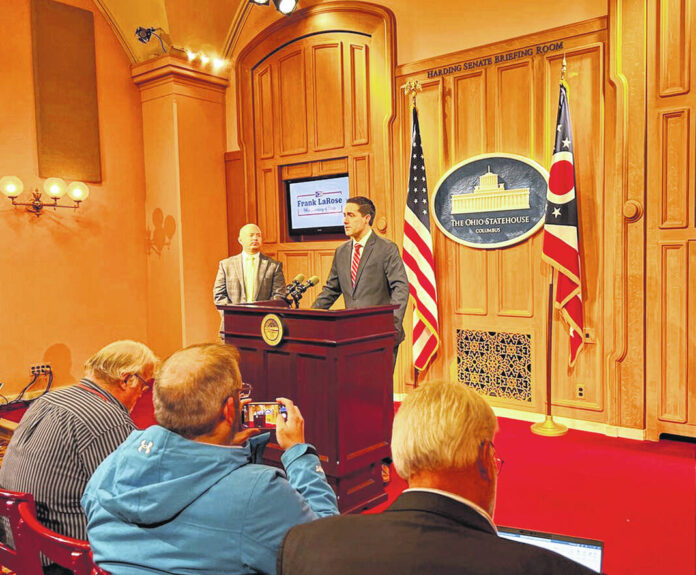COLUMBUS – Ohio Secretary of State Frank LaRose aims to raise the threshold for constitutional amendments to pass from the current 50% plus one vote at the ballot box to 60% – an idea critics warned will weaken the public’s voice and check on the General Assembly.
Under the legislation announced Thursday afternoon, the higher threshold would only apply to constitutional amendments that are initiated by citizen groups who circulate a petition to start the process.
For constitutional amendments that are initiated by the General Assembly, the threshold would remain a simple majority at ballot boxes. That’s because a 60% vote is already required in the Ohio House and Senate for a constitutional amendment bill to pass for the ballot, LaRose said.
State Rep. Brian Stewart, a Pickaway County Republican, said he will sponsor the legislation to make this change. It will have to be approved through an amendment to Article II of the Ohio Constitution, which spells out how citizens can amend the constitution.
LaRose and Stewart said the goal is for the General Assembly to pass the legislation during the lame duck session before the end of the year, and to put the question before voters on May ballots.
Reproductive rights groups are planning a constitutional amendment to enshrine abortion rights in 2023 or 2024. Voter rights groups may again attempt gerrymandering reform soon via constitutional amendment. And progressive activists have begun work on an amendment to increase Ohio’s minimum wage to $15 an hour. LaRose’s plan may get ahead of all these proposals and make it harder for them to pass.
LaRose denied that abortion or any other specific proposal is motivating him. LaRose has been the secretary of state for the last four years, and was reelected Nov. 8 to serve another four years. So why now?
“Because it’s ready now,” he replied.
LaRose said that he’s wanted to change the threshold for a while. He believes too many matters that don’t rise to the seriousness of the Ohio Constitution end up on ballots, such as the location of casinos. He would prefer many of those items to be proposed to the public as initiated statute, or citizen-passed laws.
The simple majority threshold for initiated statutes would not change under the new proposal. For groups that still decide to pursue constitutional amendments, their proposals will require more consensus and working with people on the other side of the political aisle to ensure they get 60% of the vote, he said.
LaRose said nine other states require 60% of the vote for constitutional amendments to pass: Massachusetts, Illinois, Oregon, Washington, Nevada, Nebraska, Mississippi, Wyoming and Florida. These are both “red” and “blue” states, he said.
LaRose said that too many out-of-state groups back constitutional amendments.
“Just in the past three petition-based amendment campaigns, special interest groups have spent over $50 million in disclosed money,” LaRose said. “We all know that there’s other sorts of super PAC money and that often is not disclosed, but just in disclosed money over $50 million (was spent) on the last three petition-based campaigns.”
“For far too long, the Constitution has been too susceptible to networks of outside groups and special interests seeking to alter the people’s Constitution to achieve their own ends,” Stewart said. “We have repeated watched special interests buy their way on the ballot statewide, and then spent millions of dollars traveling the airways to secure fundamental changes to our state by a vote margin of 50% plus one vote.”
However, it appears that Ohioans aren’t passing a lot of the citizen-initiated amendments. There have been 16 amendments proposed since 2000 and 11 failed. Of the five that passed, only three had 50% or more of the vote, according to information LaRose provided.
“Requiring the 60% supermajority for the passage of a constitutional amendment is a win for good government because it restores the power of popular majorities, bipartisan consensuses in deciding the enormous importance of questions such as amending our state constitution,” LaRose said. “Supermajorities are already required in the decisions made by our state legislature. I think we all know, suspending the rules, an emergency clause, overriding governor vetoes, referring a constitutional question to the ballot all require a super majority vote in the state legislature.”
“There’s nothing good government about this proposal,” said Jen Miller, executive director of the League of Women Voters of Ohio.
Citizens have been introducing ballot initiatives since 1912, she said.
It is not easy to get a constitutional amendment proposal on the ballot or passed, she said.
“It can be a check on the Ohio General Assembly when they act out of step with Ohio voters,” she said.
The League of Women voters also believes the Ohio Constitution is a sacred document, and have had concerns about the kinds of items that get proposed as constitutional amendments. However, the best way to protect the Ohio Constitution is to make it easier for citizens to get initiated statute proposals on the ballot, she said.
“Everyday Ohio citizens work to change the constitution because it takes about the same number of signatures to pass a statute, and then the Ohio General Assembly can override that statute with just a 50% plus one vote.”
Ohio House Minority Leader Rep. Allison Russo, a Columbus-area Democrat, said the proposal was an attack on democracy.
“Once again, Republicans want to change the rules to increase their own stranglehold on power,” she said in a statement. “This is an attempt to erase the voices of Ohio voters and intentionally create barriers between citizens and their democracy.”







